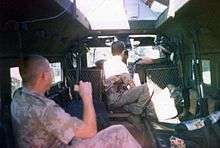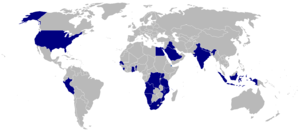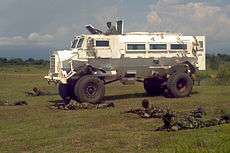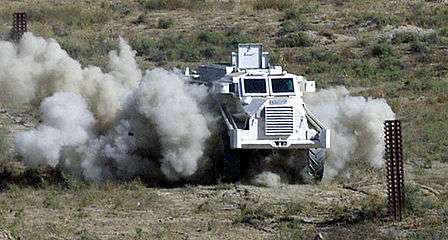Casspir
| Casspir | |
|---|---|
|
A Casspir de-mining at the Bagram Air Base | |
| Type | Mine-Resistant Ambush Protected Vehicle |
| Place of origin | South Africa |
| Specifications | |
| Weight | 10.88 t |
| Length | 6.9 m (22.64 ft) |
| Width | 2.45 m (8.04 ft) |
| Height | 2.85 m (9.35 ft) |
| Crew | 2+12 |
|
| |
Main armament | various: 3 x 7.62 mm MG or 20 mm cannon |
Secondary armament | 12 firing ports |
| Engine |
Atlantis Diesel Engines OM352A turbo-charged diesel 124 kW |
| Suspension | 4×4-wheeled |
Operational range | 770 km |
The Casspir is a Mine-Resistant Ambush Protected Vehicle that has been in use in South Africa for over 30 years. It is a four-wheeled, four-wheel drive vehicle, used for transport of troops. It can hold a crew of two, plus 12 additional soldiers and associated equipment. The Casspir was unique in design when launched, providing for passive mine defence. The main armoured steel body of the vehicle is raised high above the ground, so when a mine is detonated, the explosion is less likely to damage the crew compartment and kill the occupants. The cross-section of the hull is V-shaped, directing the force of the explosion outwards, further protecting the occupants. The vehicle also offers crew protection from small arms fire. The capabilities of the Casspir were the basis of the outline capabilities required by the U.S. Marines' for their Mine Resistant Ambush Protected or MRAP vehicle project.[1]
Design history

The name 'Casspir' is an anagram of the abbreviations of the customer, the South African Police (SAP), and the design authority, the Council for Scientific and Industrial Research (CSIR - Applied Chemistry Unit that later became MECHEM).[2] Although the Casspir was deployed in townships during the apartheid era, it was initially designed specifically for conditions encountered in the South African Border War. It was at first extensively used by the infamous "Koevoet" police counterinsurgency unit in northern Namibia during the apartheid era and later also by the South-West Africa Territorial Force's 101 Battalion and the SA Army's 5 Reconnaissance Regiment. The chief criteria for the design was good off-road mobility, armour protection against small arms fire and anti-personnel mines, and ease and speed of repair by a light workshop crew in the field after detonating an anti-tank mine.[3] These requirements led to the distinctive V-shaped hull (for mine protection) and a wheeled chassis.
The Casspir was designed by the Defence Research Unit (DRU)[3] of CSIR specifically to protect vehicle occupants against landmines. It is certified to protect its occupants against a triple TM-57 mine blast (equivalent to 21 kg of TNT) under a wheel, or a double blast (14 kg of TNT) under the hull. The Casspir has V-bottomed armoured monocoque hull, designed to deflect the force of an explosion outwards, to which a leaf-spring suspension is attached.[2]
Production history
After two years of field testing, the South African Police were eventually satisfied they had a good vehicle and in March 1980 placed an order for an initial 140 Casspirs. Some 190 Mk1 Casspir were manufactuered by Henred Fruehauf. In 1981 production was taken over by TFM, which improved the design to the Mk 2. TFM was subsequently taken over by Reumech OMC. Reumech in turn was taken over by Vickers Defence Systems of the UK and renamed Vickers OMC. When Alvis purchased Vickers Defence Systems to become Alvis Vickers, Vickers OMC became Alvis OMC. In 2004 BAE Systems acquired Alvis Vickers and Alvis OMC was renamed Land Systems OMC. Land Systems OMC was 75 per cent acquired by Denel in 2015. [4] An estimated 2800 Casspir of all types have been built.[3]
The South African Police Service auctioned off some of their surplus Casspirs to the public at a 2008 auction.[5]
A new Casspir known as Casspir NG 2000 is being manufactured by Denel Mechem.[6][7] The vehicle was launched in April 2013.[3]
Variants


- Casspir Mk 1. Made extensive use of Mercedes-Benz truck components.[3] First use in combat: Koevoet, South West African Police
- Casspir Mk 2 First user: 101 Battalion, South West African Territorial Force
- Casspir Mk 2C (I)
- Casspir Mk 3 - 170 hp (127 kW) ADE-352T 6-cylinder turbo-diesel
- Ordnance Factories Board of India's MPV Casspir Mk. 6 Protector - modification to the wheel 6 × 6 and 4 × 4, created on the truck chassis Ural-4320 , equipped with Russian turbodiesel YAMZ-236NE2, 230 hp (169 kW) and a manual transmission YAMZ-236U. Mine protection provides undermining the 21 kg charge under the wheel and 14-kg charge under the body of the machine. The machine is designed in conjunction South African company BAE Systems Land Systems South Africa and Indian Mahindra & Mahindra, produced in a joint venture Defence Land Systems India (DLSI) in India. In India, the armored car was designated - MPVI (Mine Protected Vehicle for India). [8]
- Casspir 2000 (Mercedes Benz Based)
- Casspir 2000B (Powerstar - North Benz Based)
The Casspir was built in different configurations:
- APC - armoured personnel carrier[9]
- Artillery Fire Control vehicle
- Ambulance
- Blesbok Freighter - with drop side cargo area for up to 5 tons (160 built). Can be used as a weapon platform.
- Duiker Tanker - 5000 litre tank (30 built); originally with 3000 litre tank[3]
- FISTV - Fire Support Team vehicle
- Gemsbok Recovery vehicle - 15-ton capacity (30 built)
- Mechem Mine clearing vehicle - uses steel wheels to detonate mines
- MEDDS (Mechem Explosives and Drug Detection System) Mine Sensor vehicle
- Mechem VAMMIDS (Vehicular Array Mine Detection System) Vehicle
- Plofadder Mine clearing System - carrier of the containerised Plofadder 160AT rocket-propelled mine clearing system
- Riot Control vehicle - Police version with larger windows to increase visibility
- Mechem LP (Low-Profile) and short-wheelbase vehicle
- Casspir Dumpy - A shortened version (1 m shorter)developed and purchased by the SA Army in 1982 to be evaluated against the requirements for the Buffel replacement project. Did not enter production[3]
- Sesspir - In 1984-85 the CSIR developed a prototype Casspir with six wheels. An additional non-driven axle was fitted in front of the front drive axle, this to be sacrificed in the event of a landmine detonation. It steered along with the regular driven front wheels and was equipped with winch cables to hoist either side of the axle clear off the ground in the event of the loss of a wheel. The theory being the vehicle would remain mobile. The idea was shelved as one of numerous problems was simply a lack of power from the engine to push the undriven axle along through bush and soft sand. Only one prototype was built.[3]
Operators


 Angola: 16[10]
Angola: 16[10] Benin: 10 Casspir 2000 on order[11]
Benin: 10 Casspir 2000 on order[11] Burundi: 10[10]
Burundi: 10[10] Democratic Republic of the Congo[12]
Democratic Republic of the Congo[12] Djibouti: 10[13]
Djibouti: 10[13] Egypt[14]
Egypt[14] Ghana: 4[15]
Ghana: 4[15] India: 165[16]
India: 165[16] Indonesia: Used by Kopassus[13][16]
Indonesia: Used by Kopassus[13][16] Iraq[10]
Iraq[10] Malawi: 12[10]
Malawi: 12[10] Mozambique: 15[10]
Mozambique: 15[10] Namibia: 20 inherited from the South West African Territorial Force.[13]
Namibia: 20 inherited from the South West African Territorial Force.[13] Nepal: 37[10][16]
Nepal: 37[10][16] Peru: Policía Nacional del Peru (DIROES)[13][16]
Peru: Policía Nacional del Peru (DIROES)[13][16] Saudi Arabia: 9[15]
Saudi Arabia: 9[15] Senegal: 9[10]
Senegal: 9[10] Sierra Leone: 3[17]
Sierra Leone: 3[17] South Africa: 370 in South African Army service.[13][18]
South Africa: 370 in South African Army service.[13][18]  Tanzania: 5[15]
Tanzania: 5[15] Uganda: 42[15]
Uganda: 42[15] United States: 68[10][16]
United States: 68[10][16]
Combat history
- Angolan Civil War
- Caprivi conflict
- Iraq War
- Second Congo War
- South African Border War
- African Union Mission to Somalia
See also
- Buffalo (mine protected vehicle), a 6x6 originally built by Force Protection Inc
- Cougar (vehicle), a 4x4 originally built by Force Protection Inc
- Buffel, an early South African mine protected vehicle
- Oshkosh M-ATV, current generation lighter weight mine protected vehicle manufactured by Oshkosh Corporation
References
| Wikimedia Commons has media related to Casspir. |
- ↑ "Retasking MRAP: Life after Afghanistan". Jane's International Defence Review. 2 April 2015. Retrieved 27 July 2015.
- 1 2 "Casspir". GlobalSecurity.org.
- 1 2 3 4 5 6 7 8 "Surviving The Ride ISBN 978-1-928211-17-4". 30 Degrees South. Retrieved 2015-07-27.
- ↑ "BAE Completes S. African Unit Sale to Denel". Deagel.com. 2015-04-28. Retrieved 2015-07-25.
- ↑ Independent Newspapers Online. "A chance to own a Casspir". Independent Online. Retrieved 5 November 2014.
- ↑ "Mechem sells CASSPIR 2000s to Benin and the UN". DefenceWeb. 2013-02-05. Retrieved 2013-04-23.
- ↑ "Denel Introduces the Next Generation Casspir 2000 Mine Resistant Vehicle". Deagel.com. 2013-04-11. Retrieved 2013-04-23.
- ↑ http://bmpd.livejournal.com/58391.html Casspir Mk 6 on the basis of "Ural"
- ↑ "2011 February". Sadfgroup.org. 2011-02-15. Retrieved 2013-04-23.
- 1 2 3 4 5 6 7 8 Leon Engelbrecht. "South African Arms Exports". Retrieved 5 November 2014.
- ↑ "Benin purchases ten Casspir 2000 4x4 mine protected vehicle from South African Company Mechem 1002133 - Army Recognition". Armyrecognition.com. 2013-02-10. Archived from the original on 2013-02-13. Retrieved 2015-08-30.
- ↑ "Scramble for the Congo - Anatomy of an Ugly War" (PDF). ICG Africa. 2000-12-20. Archived from the original (PDF) on 2013-10-29. Retrieved 2013-06-18.
- 1 2 3 4 5 "An MRAP for India". Defenseindustrydaily.com. 2013-02-12. Retrieved 2013-04-23.
- ↑ http://www.egyptmineaction.com/web/en/wp-content/uploads/2012/01/Casper.pdf
- 1 2 3 4 "Trade Registers". Armstrade.sipri.org. Retrieved 2015-01-01.
- 1 2 3 4 5 Camp, Steve; Helmoed-Römer, Heitman (November 2014). Surviving the Ride: A pictorial history of South African Manufactured Mine-Protected vehicles. Pinetown: 30 Degrees South. p. 240. ISBN 978-1928211-17-4.
- ↑ "UN Register". Retrieved 5 November 2014.
- ↑ "home". Army.mil.za. 2010-12-13. Retrieved 2014-04-16.
External links
- Casspir webpage
- Video; Mechem - Vehicle Business inc. Casspir
- Video; Mechem - Casspir
- Video; N4Trucks - Casspir
- Video; Casspir MkIV
- Video; Casspir MkIV launch at AAD 2010
